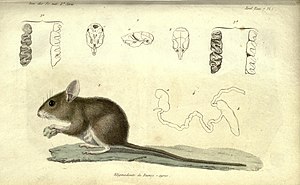Highland gerbils
| Highland gerbils | ||||||||||||
|---|---|---|---|---|---|---|---|---|---|---|---|---|

Highland gerbil |
||||||||||||
| Systematics | ||||||||||||
|
||||||||||||
| Scientific name | ||||||||||||
| Eligmodontia | ||||||||||||
| F. Cuvier , 1837 |
The highland gerbils ( Eligmodontia ) are a genus of rodents from the group of New World mice that lives in South America . They include five types.
These animals are relatively small, mouse-like animals with long tails and large ears. They reach a head body length of 7 to 11 centimeters and a tail length of 5 to 11 centimeters. The weight is 7 to 31 grams. The long, soft fur is colored yellow-brown on the upper side, the underside (sometimes only the throat and chest) is white. The tail is hairy, the hind legs are elongated and have hairy pads on the soles.
They inhabit dry grasslands and rocky areas and occur at heights of up to 4575 meters. Their distribution area extends from southern Peru via Bolivia to southern Chile and Argentina .
They are nocturnal and do not build their own burrows, but refer to those of other animals or natural hiding places as shelter. Their diet consists of seeds, green parts of plants (such as salt plants ), but also insects.
The mating season extends from October (spring) to April (autumn). The female can have several litters, the litter size is two to nine young animals.
There are five types:
- Eligmodontia dunaris is at home in the dunes of the Atacama Desert in northern Chile
- Eligmodontia moreni lives in the Andean region in northwest Argentina.
- Eligmodontia morgani is common in southern Argentina and the neighboring regions of Chile.
- Eligmodontia puerulus occurs from Peru to northern Argentina.
- Eligmodontia typus lives in eastern Patagonia.
According to the IUCN , none of the species is threatened, but this information is out of date.
literature
- Ronald M. Nowak: Walker's Mammals of the World. 2 volumes. 6th edition. Johns Hopkins University Press, Baltimore MD et al. 1999, ISBN 0-8018-5789-9 .
- Don E. Wilson , DeeAnn M. Reeder (Eds.): Mammal Species of the World. A taxonomic and geographic Reference. 2 volumes. 3. Edition. Johns Hopkins University Press, Baltimore MD 2005, ISBN 0-8018-8221-4 .
Individual evidence
- ↑ Angel E. Spotorno et al .: A small, new gerbil-mouse Eligmodontia (Rodentia: Cricetidae) from dunes at the coasts and deserts of north-central Chile: molecular, chromosomic, and morphological analyzes. In: Zootaxa . Vol. 3683, No. 4, ISSN 1175-5326 , pp. 377-394, doi : 10.11646 / zootaxa.3683.4.3 .
Web links
- Endangerment level of the individual species in the IUCN Red List of Threatened Species .